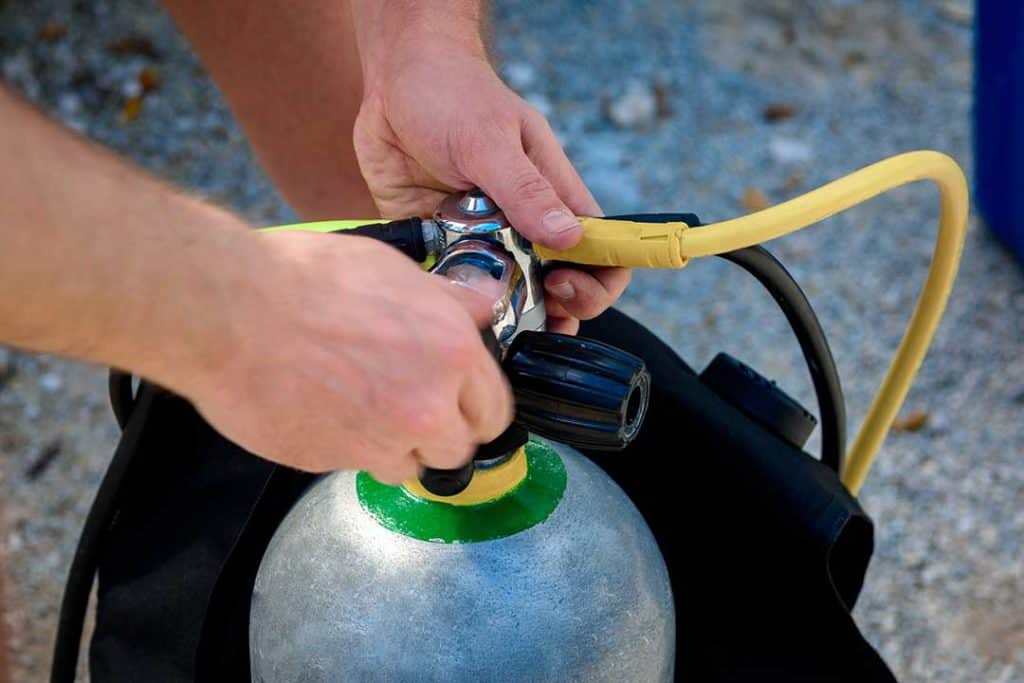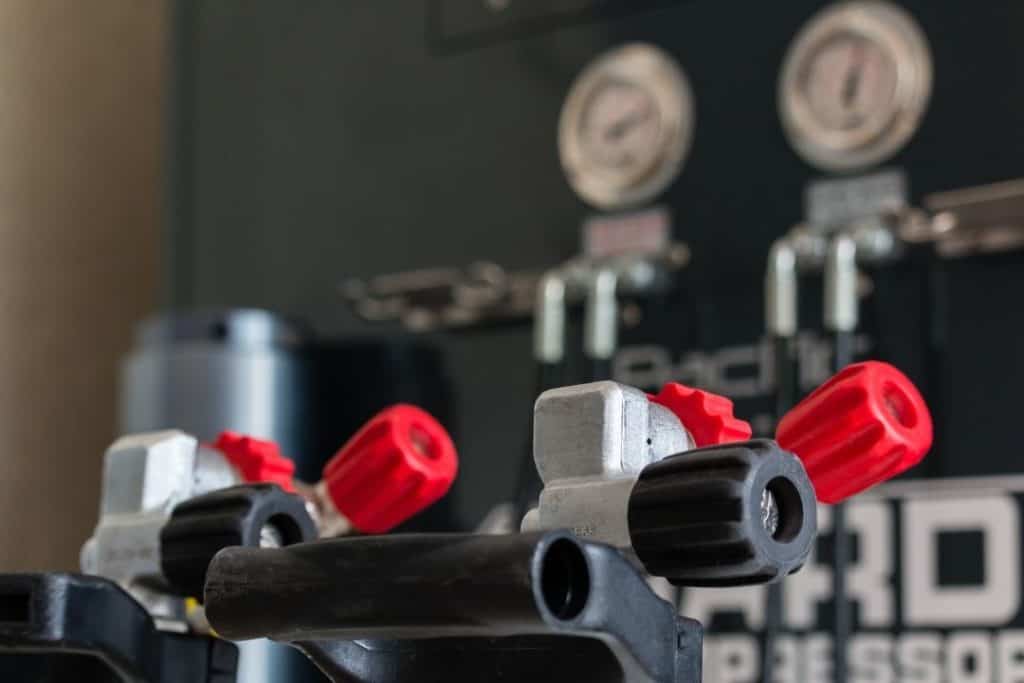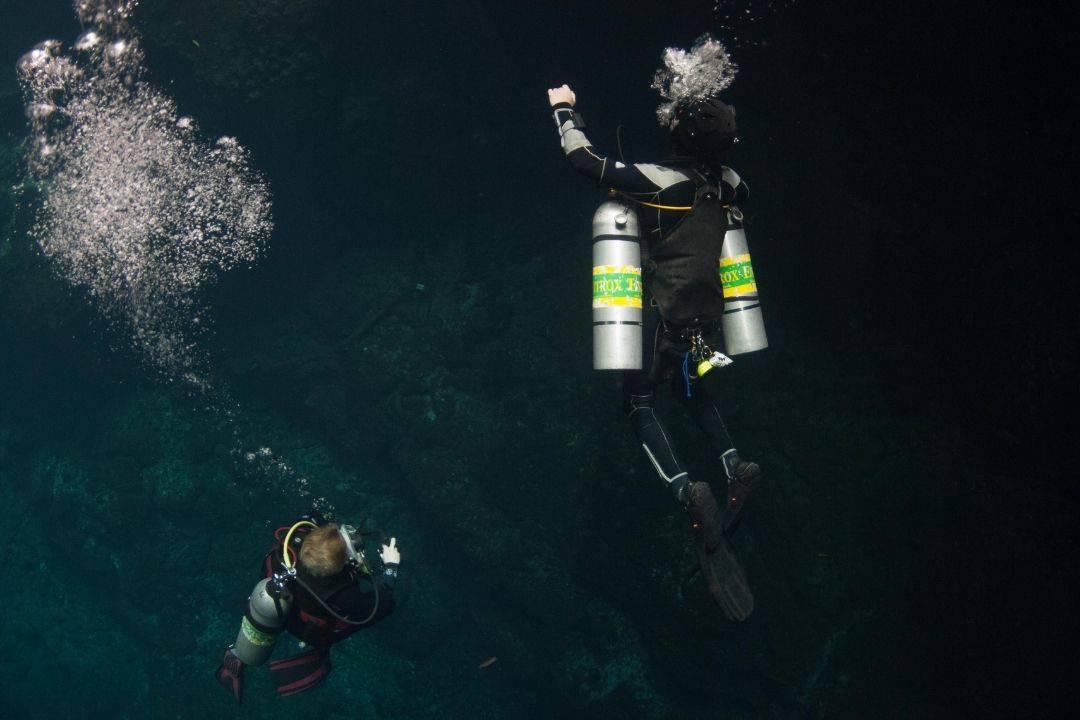If you own your own scuba tanks, you may wonder if you can put air into a tank marked for Nitrox. And vice versa. Using an EAN mix can have many benefits. However, not every dive profile will see those benefits.
Nitrox fills are more expensive, so why pay the extra if you not need it. There is no concern putting standard air into your Nitrox tank.
The potential for problems occur when you try to do a Nitrox fill with a tank that contained standard air. Standard air has hydrocarbons in it.
Under normal levels and circumstances this does not cause any concerns. When exposed to high pressure and high levels of oxygen, the hydrocarbons can burst into flames.
This situation can occur during the filling process of a tank that has not been oxygen serviced after a normal fill. I will give a fuller explanation in the rest of this article.
Can you fill a Nitrox tank with air?
Filling a Nitrox tank with air is possible. However, once you do the tank is no longer safe to be used for Nitrox until it has been oxygen serviced.
Any tank having a standard air fill will need to be serviced before using EAN. If you plan on using both air and Nitrox, it may be best to get a second tank.
The 40% Rule

There are a number of different terms that have different meanings in various industries and locations. Recreational divers can use an Enriched Air Nitrox blend that contains 40% oxygen.
This 40% limit is not totally arbitrary.
nce we exceed this threshold, there are more concerns both safety and the impact on the diver. Technical divers may have a need to use a higher percentage.
Their additional training help them adapt to the increase risk and measures needed to dive with the higher percentages of oxygen.
The term oxygen-enriched air is a gas industry term for air with 50% to 95% oxygen. Some safety organizations use the term for mixtures from 23.5% to 50%, These safety organizations define oxygen as any mix with 50% or more oxygen.
Due to the role oxygen plays in combustion and properties of gases under pressure, there are many regulations on transporting, storing and using oxygen.
Any additional oxygen can be a concern for combustion. I am sure we have all at one time or another fanned, or blown on embers to get some flames.
A fire needs three things: fuel, temperature and oxygen. When we blow across those hot embers, we are increasing the oxygen. Since it has a fuel source, it can burst into flames.
Devices used to store oxygen must be oxygen serviced. This is a cleaning process where materials, that under situations of high oxygen and pressure could combust, are removed.
This process is also called oxygen clean. Oxygen serviced is critical for high pressure and high oxygen situations, however, it is not for lower pressures or lower oxygen percentages. As an example, an oxygen tank in a hospital will have been oxygen serviced before being filled.
The tube from the tank and the face mask over the patient’s face will not need to be as the oxygen is just slightly over normal pressure.
In a similar situation, while diving with an EAN under 40% our regulator would not have to be oxygen serviced.
Our Nitrox tank should be. Once we use a Nitrox tank with regular air, it is no longer consider oxygen serviced.
Author
Why Does a Nitrox Tank Need To Be Oxygen Serviced

The air we breathe from our regular scuba tanks should be what is called a Grade E breathing gas. The oxygen content is between 20-22% and has a water vapor content of less than 67 ppm.
The low water vapor is the reason many divers have a dry throat after a dive. The standard for Grade E allows for up 25 ppm of volatile hydrocarbons.
This is often an oil residue from the compressor. While most of the hydrocarbons stay in the air and exit the tank as we breathe, some will adhere to the inside of the cylinder.
Over time more hydrocarbons will remain in the tank.
Let’s take a step back as to what is Enriched Air Nitrox. We know that EAN is a breathing gas with more oxygen that normal air.
It is reasonable to think that oxygen has been added to the air. In reality, EAN is oxygen that has been diluted by regular air.
Generally, 100% oxygen is added to a cylinder until a certain pressure is reached. Then additional air is added until the desired pressure is reached. This process will reduce the percentage of oxygen in the final EAN mixture.
The additional air added is a Grade E breathing gas that has been filtered to remove more hydrocarbons. Not all the hydrocarbons are removed so some contamination of the cylinder will happen.
Let’s put all this random information together. We have a tank that is not oxygen service and start the filling process.
The tank is filled with 100% oxygen and then more oxygen is added to bring up the pressure. We now have two of the items needed to create a fire, oxygen and fuel the hydrocarbons.
As the pressure of the oxygen increase, the temperature will as well. That heat is transferred to the walls of the cylinder and to any material inside the cylinder, like the hydrocarbons.
We are now also adding the third element, heat. Depending on the amount of heat and the concentration of the fuel, we may reach the flash or fire points of the hydrocarbons.
Given that we are in an enclosed environment, the cylinder, we may have a deflagration.
A deflagration is a fire in which a flame travels rapidly, but at subsonic speed, through a gas.
Technically it is not an explosion, however, the extreme heat will increase the pressure while at the same time weakening the cylinder until it ruptures.
To prevent this situation from happening, the dive cylinder needs to be oxygen serviced once a year or anytime after it been used with the standard Grade E breathing gas.
Partial Pressure or Premix Fill

The method mentioned above with adding 100% oxygen and then a filtered Grade E gas is called a partial pressure fill. It is the most common method to fill EAN tanks.
The fill station should be able to give you a mix with whatever percent of oxygen you desire.
There are fill stations that will use a premix fill. A premix fill is one where the cylinder is filled with a breathing gas already at the desired EAN-X.
This can be done in a banking or cascading system where large tanks are filled which in turn are used to fill the individual scuba tanks. In many parts of the world, it is very difficult to obtain pure oxygen due to legal restrictions and handling requirements.
Here, a fill shop may purchase an EAN mix from a gas supplier. You would most likely only have EAN-32 and EAN-38 to chose from.
When using a premix, the contents of the scuba tank will not receive oxygen over the desired percentage.
While many fill stations may still require the tank be oxygen serviced, it is not a safety hazard if it is not.
It is also possible that a fill station may use both the partial pressure method and the premix method.
If you have your own scuba tanks and wish to use both air and EAN, it would be much better to have separate tanks.
It would not take long before the cost of getting one tank oxygen serviced, after using air, is more than the cost of dedicated tanks.
Feel free to add your comments or questions below.


